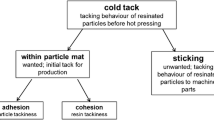Abstract
A previously developed rheometer-based method to examine undesired cold tack (“sticking”) of aminoplastic resins to machinery parts was further modified to enable climate depending measurements. It could be shown that both relative humidity and temperature influence sticking, resulting in a variation in the extent of sticking as well as in the time window of occurrence. The laboratory method has been successfully applied to explain cases of sticking in a particleboard factory.



Similar content being viewed by others
References
ASTM E1333 (2010) Standard test method for determining formaldehyde concentration in air and emission rates from wood products using a large chamber. Annu Book ASTM Stand 04:10
Barbu MC, Resch H, Pruckner M (2000) Aspekte der Benetzbarkeit von MDF-Platten (on the wettability of medium density fiberboards). Holzforsch Holzverwert 52:63–65
Berthold K (1989) Lexikon der Holztechnik (Lexicon of wood technology). Fachbuchverlag, Leipzig
Dunky M (1998) Urea-formaldehyde (UF) adhesive resins for wood. Int J Adhes Adhes 18:95–107
Dunky M (2003) Adhesives in the Wood Industry. In: Pizzi A, Mittal KL (eds) Handbook of adhesive technology, 2nd edn. Marcel Dekker Inc., New York, pp 887–956
Dunky M, Niemz P (2002) Holzwerkstoffe und Leime—Technologie und Einflussfaktoren (wood composites and adhesives—Technology and influencing factors). Springer, Berlin, pp 245–644
EN 923 (2005) Adhesives—terms and definitions. European committee for standardization, Brussels
Gierlińska I, Starzyńska K (1986) Untersuchung der Kaltklebrigkeit von Harnstoff-Formaldehyd-Harzen aus konzentriertem Formalin (Investigation of cold tack of UF resins made from concentrated formalin). Holztechnologie 27:149–151
Hammond FH (1982) Tack. In: Satas D (ed) Handbook of pressure sensitive adhesive technology. R. van Nostrand, New York, pp 38–60
Himsel A, Müller U, Kantner W, Moser J, Mitter R, van Herwijnen HWG (2015a) Novel analytical method to determine factors causing unwanted sticking of glued wood particles onto machinery parts. For Prod J 65(1–2):54–59
Himsel A, Moser J, Kantner W, Mitter R, Gießwein J, van Herwijnen HWG, Müller U (2015b) Describing the sticking phenomenon of aminoplastic resins: introduction of a new test method. Wood Sci Technol 49:681–694
IARC (2006) IARC Monographs on the evaluation of carcinogenic risks to humans 88: 280
Kantner W, Moser J, Heinemann C, Stöckel F (2009) Novel analyses of low-emission UF and MUF resins. In: Frihart CR, Hunt CG, Moon RJ (eds) Wood adhesives 2009. Forest Products Society, Madison, pp 357–365
Kariz M, Kuzman MK, Sernek M (2013) The effect of heat treatment of spruce wood on the curing of melamine-urea-formaldehyde and polyurethane adhesives. J Adhes Sci Technol 27(17):1911–1920
Leichti RJ, Hse CY, Tang RC (1988) Effect of synthesis variables on tack in urea-formaldehyde resin. J Adhesion 25:31–44
Myers G (1984) How mole ration of UF resin affects formaldehyde emission and other properties—a literature critique. For Prod J 34:35–41
Sahaf A, Englund K, Laborie MPG (2012) Tack and shear strength of hybrid adhesive systems made of phenol-formaldehyde, dextrin and fish glue, and acrylic pressure-sensitive adhesive. Holzforschung 66:73–78
Schlusen K (2008) Low emission panels—experiences of a panel producer, Technical Formaldehyde Conference, 13–14 Mar 2008, WKI, Braunschweig, Germany. In: Steckel V (2008) Formaldehyd und seine Grenzwerte global betrachtet (Formaldehyde and its treshold limit values from a global perspective), Holz-Zentralblatt 15:410–411
Schneider F (2006) Verfahren und Vorrichtung zur Verhinderung von Verunreinigungen einer Transporteinrichtung aufgrund frischbeleimter Fasern (Method and device for prevention of contamination of a transport device by freshly sized fibres). World Patent Application WO 2006050840, 18.05.2006
Acknowledgments
The authors thank the European Union and the state of Lower Austria for financial support through EFRE (ERDF; European Regional Development Fund), project number WST3-T-9/021-2012).
Author information
Authors and Affiliations
Corresponding author
Rights and permissions
About this article
Cite this article
Himsel, A., van Herwijnen, H.W.G., Moser, J. et al. Describing the sticking phenomenon of aminoplastic resins: dependency on temperature and relative humidity. Eur. J. Wood Prod. 74, 31–36 (2016). https://doi.org/10.1007/s00107-015-0990-1
Received:
Published:
Issue Date:
DOI: https://doi.org/10.1007/s00107-015-0990-1




